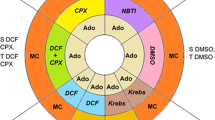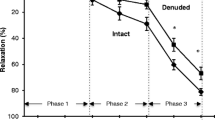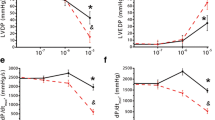Summary
The efficiency of adenosine to relax the bovine coronary arterial strips increased significantly by lowering the bath pH from 7.4 to 6.8 (CO2 or HCO −3 ). The large vessels (3–4 mm O.D.) relaxed with greater significance at higher concentrations of adenosine, whereas small vessels (0.5–0.7 mm O.D.) relaxed better at low concentrations of adenosine. Theophylline and 8-phenyltheophylline competitively inhibited the effect of adenosine. 8-phenyltheophylline was found to be a better antagonist than theophylline. Furthermore, binding assays with 2-3H adenosine displayed a single species of binding sites. The Kd was 3×10−6 M and 4×10−6 M, while Bmax was 48 and 19 pmoles/mg protein for small and large vessels, respectively. The antagonistic effect of theophylline and 8-phenyltheophylline was not affected by pH variations. It is concluded that relaxation of coronary arteries by adenosine is affected by pH variations.
Similar content being viewed by others
References
Afonso, S., T. J. Ansfield, T. B. Berndt, and G. G. Rowe: Coronary vasodilatory response to hypoxia before and after aminophylline. J. Physiol.221, 589–599 (1972).
Atkinson, J. M., and M. J. Rand: Reduction of cardiovascular responses to some sympathomimetic amine during hypercapnia. Europ. J. Pharmacol.18, 166–173 (1972).
Berne, R. M.: Cardiac nucleotides in hypoxia: A possible role in regulation of coronary blood flow. Amer. J. Physiol.204, 317–322 (1963).
Dutta, P., and S. J. Mustafa: Saturable binding of adenosine to the dog heart microsomal fraction: competitive inhibition by aminophylline. J. Pharmacol. Expt. Ther.211, 496–501 (1979).
Dutta, P., and S. J. Mustafa: Binding of adenosine to the crude plasma membrane fraction isolated from dog coronary and carotid arteries. J. Pharmacol. Expt. Ther.214, 496–502 (1980).
Fenton, R. A., R. Rubio, R. M. Berne: Effect of adenosine on the acid base state of vascular smooth muscle (Abstr.). Fed. Proc.39, (3) 832 (1980).
Foley, D. H., E. A. Amsterdam and D. T. Mason: Interaction of vasoactive effects of adenosine and potassium ion on isolated feline coronary artery smooth muscle. Circulat. Res.44, 207–215 (1979).
Gellai, M., J. M. Norton, R. Detar: Evidence for direct control of coronary vascular tone by oxygen. Circulat. Res.32, 279–289 (1973).
Ghai, G. and S. J. Mustafa: Binding of adenosine to plasma membrane fraction of cultured smooth muscle cells (Abstr.). Pharmacologist21, 678 (1979).
Ghai, G., and S. J. Mustafa: Relaxation of arterial strips by adenosine convalently bound to glass beads (Abstr.). Phamacologist22, (3) 269 (1980).
Haddy, F. J., and J. B. Scott: Metabolically linked vasoactive chemicals in local regulation of blood flow. Physiol. Rev.48, 688 (1968).
Harder, D. R., L. Belardinelli, N. Sperelakis, R. Rubio, R. M. Berne: Differential effects of adenosine and nitroglycerine on the action potentials of large and small coronary arteries. Circulat. Res.44, 176–182 (1979).
Ichihara, K., M. Ichihara, Y. Abiko: Involvement of β adrenergic receptors in decrease of myocardial pH during ischemia. J. Pharmacol. Expt. Ther.209, 275–281 (1979).
Kontos, H. A.: Role of hypercapnic acidosis in the local regulation of blood flow in skeletal muscle. Circulat. Res.28, and29 (Suppl. 1), 98–105 (1971).
Mustafa, S. J.: Effect of varying pH (H+) on the metabolism of adenosine in isolated heart cells. J. Mol. and Cell. Cardiol.12, 335–346 (1980).
Olsson, R. A., C. J. Davis, E. M. Khouri, R. E. Patterson: Evidence for an adenosine receptor on the surface of dog coronary myocytes. Circulat. Res.39, 93–98 (1976).
Schrader, J., E. Nees, E. Gerlach: Evidence for a cell surface adenosine receptor on coronary myocytes and atrial muscle cells. Pflügers Arch.369 251–257 (1977).
Schnaar, R. C., and H. V. Sparks: Response of large and small coronary arteries to nitroglycerine, NaNO2 and adenosine. Amer. J. Physiol.223, 223–228 (1972).
Schwabe, U., H. Kiffe, C. Puchstein, and T. Trost: Specific binding of3H-adenosine to rat brain membranes. Arch. Pharmacol.310, 39–67 (1979).
Van Harn, G. L., R. Rubio, and R. M. Berne: Formation of adenosine nucleotide derivatives in isolated dog carotid artery strips. Amer. J. Physiol.233, H229-H304 (1977).
Author information
Authors and Affiliations
Additional information
This work was supported by HL27339
Rights and permissions
About this article
Cite this article
Mustafa, S.J., Ghai, G. Effect of adenosine on the relaxation of coronary arteries at varying pH values. Basic Res Cardiol 76, 380–386 (1981). https://doi.org/10.1007/BF01908327
Issue Date:
DOI: https://doi.org/10.1007/BF01908327




